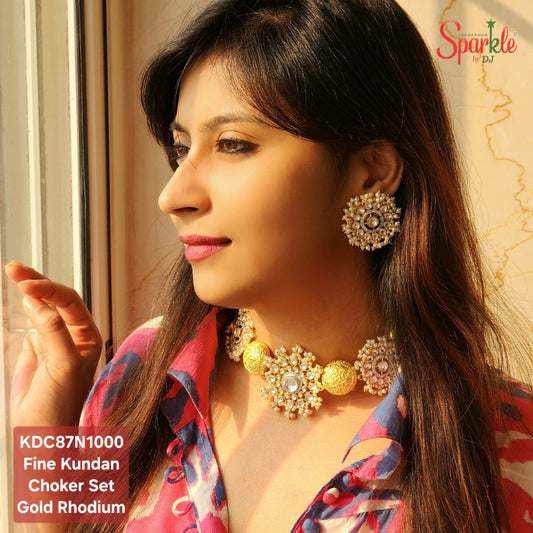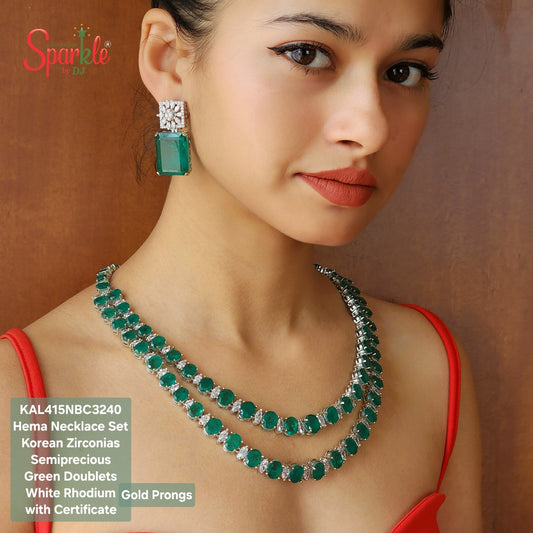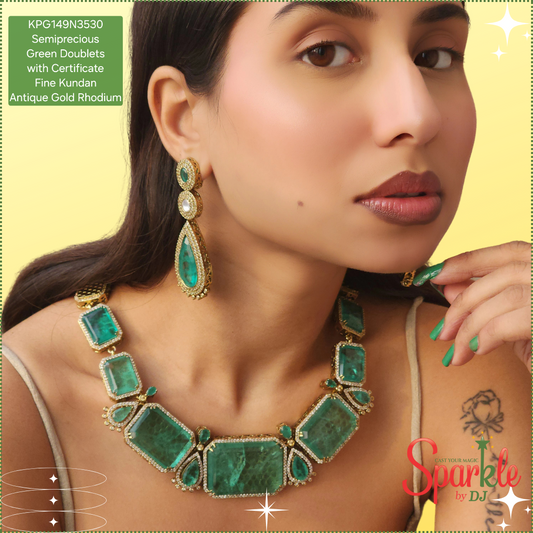Exploring the History of Traditional Necklace Sets Around the World
Share
The principal part of a traditional necklace set is the band, chain, or cord that encircles the neck. These are usually from valuable metals. Metals such as gold, silver, and platinum. Traditional necklace sets have additional embellishments hanging or set into the necklace itself. These attachments typically consist of pendants, lockets, talismans, and crosses. Traditional necklace sets can be of precious and semi-precious material, such as diamonds, pearls, rubies, emeralds, garnets, and sapphires. They are of a variety of materials and serve various purposes.
Traditional necklace set
A traditional necklace set is a piece of jewellery we wear around the neck. Traditional necklace sets might have been among the early forms of decoration. Necklace sets traditional often have ceremonial, religious, or burial purposes. These are also symbols of prosperity and status. Given that they are usually from valuable metals and gemstones. Traditional necklace sets are similar to rings, always worn items.

History of traditional necklace set
People have been wearing traditional necklace sets since the beginning of human civilization. The earliest traditional necklace set consisted of natural shells or stones. This has been in ancient burial sites.
The ancient Egyptians frequently made beads from glass and glazed pottery and used these to create traditional necklace sets. In ancient times, beads were a decoration. It also served as an important trading item and a form of currency.
Beads from various cultures spread far and wide, as did the tradition of wearing traditional necklace sets. The invention of the chain also led to the popularity of pendant traditional necklace sets.
We know that in ancient Egypt and Greece, it was common to wear charms around the neck. It was for protection from evil. In the Middle Ages, traditional necklace sets were also a symbol of power and authority.
Both kings and the clergy wore large necklaces set traditional. Necklace set traditional made of gold, enamel, and gemstones. During the late Gothic and early Renaissance periods, necklace sets traditional became a more important part of attire. In comparison to brooches and began to signify wealth and social status.
The earliest evidence of traditional pearl necklace sets dates back to 70,000 B.C. In ancient Egypt, there were remarkable pieces featuring vibrant colours made with polychrome beads. Around 330 B.C. in Greek times, fringe traditional pearl necklace sets were in fashion. There are examples of necklaces from the Roman era, the Middle Ages, and the Renaissance.
Also continuing through the 17th and 18th centuries. It is a type of jewellery that has maintained its popularity over time despite changes in styles, shapes, and materials.
The first traditional pearl necklace set was from natural materials such as bones, feathers, teeth, and shells. Examples of these have been in a Neolithic burial site. Also, dating back to around 4200-3400 B.C. Other early necklaces were from twisted metal. It was a torque, which ancient Celtic people in Ireland and Scotland wore between 1800-1500 B.C.E. Necklaces were not very popular during the Gothic period from 1150 to 1450 C.E.
Today, we wear necklaces to express our passionate beliefs or to adorn ourselves. However, initially, they were for celebratory, religious, and funerary purposes. In some societies from the 14th to the early 17th century, necklaces adorned with gemstones and gold were a symbol of prestige and wealth. Over time, necklaces replaced brooches, which were the most popular form of traditional choker necklace set during the Middle Ages.
History of Greece
In Ancient Greece, fine traditional choker necklace sets were of repoussé and braided gold wires. These sets were with blue or green enamelled rosettes, animal figures, or vase-shaped pendants with decorative fringes.
It was also common to wear long gold chains with suspended cameos and small containers of perfume. During the Hellenistic period, new features were introduced. Such as the use of coloured stones to create polychromatic pieces, as well as the addition of animal-head finials and spear-like or bud-shaped pendants hanging from chains.
The Ancient Etruscans utilized granulation to produce granulated gold beads.
In Ancient Rome, necklaces were popular among the Roman elite. Gold and silver traditional necklace sets were with semi-precious objects. This includes amber, pearls, amethyst, sapphire, and diamonds. Additionally, they wear ropes of pearls, gold plates inset with enamel, and lustrous stones set in gold filigree. Many of the large traditional necklace sets and the materials adorning them were from the Near East.
History of Ancient India
Traditional necklace sets have played a significant role in the adornment of both men and women for many years. India is fortunate to have a rich cultural history that places great importance on traditional necklace sets. Today's Indian jewellery is a fusion of influences from various sources and cultures.
The roots of jewellery in India are from over 5000 years. With evidence of its presence throughout the country's history. In the past, India was the primary source of gemstones for the world. For royalty, jewels symbolized wealth and status. Traditional necklace set pieces have been in Mohenjodaro and the Indus Valley, showcasing intricate designs and craftsmanship.
The period of Mughal rule introduced ornate necklace sets traditional that combined Indian and Central Asian styles. Featuring intricate enamel work. The techniques of jewellery-making that the Mughals introduced, continue to be in use today. With Indian designers further develop them to incorporate various elements such as floral and nature-inspired designs.
The diverse range of necklace set traditional designs in India is a result of their origins in different regions. It is an inspiration from diverse cultures and lifestyles. For instance, the nature designs in the gold jewellery of Tamil Nadu and Kerala are a reflection of this cultural influence.
Conclusion
The modern and contemporary designs have evolved from traditional necklace set designs for the new generation, yet, the timeless appeal and significance of traditional styles and jewellery designs in Indian jewellery will always endure. We hope you found this information interesting and useful. Shop your favourite traditional jewellery from SparklebyDJ.
| kag8n2980 silver earrings |
| kal119n325 cuff style long earrings |
| kal160n850 cz necklace set |
| kal206n100 bali earrings |
| kal207n110 tennis bracelet |




